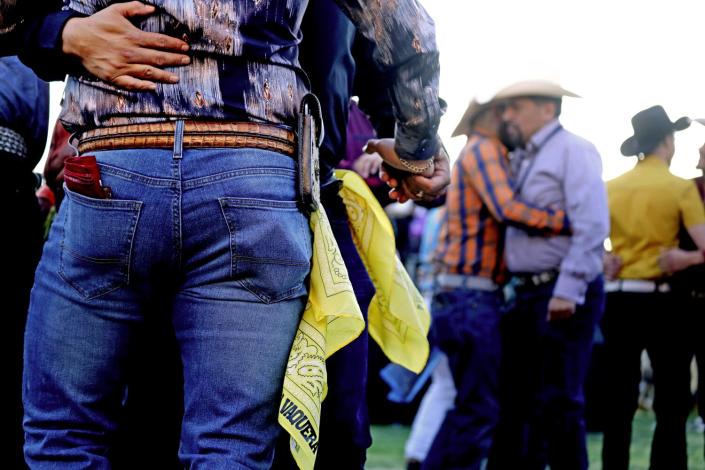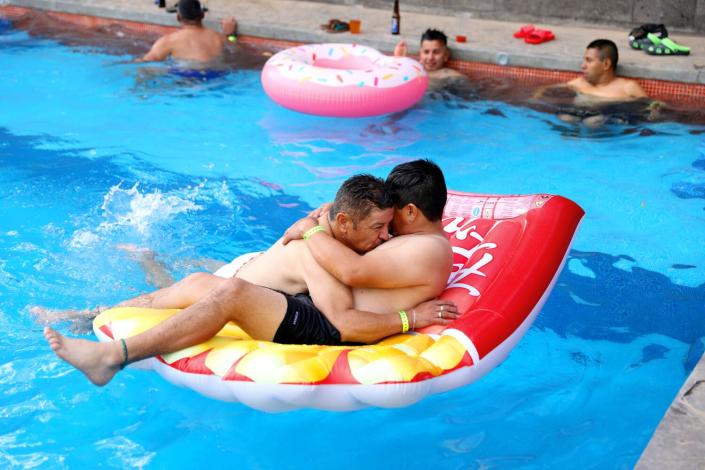
All night long, cowboys swaggered into a packed nightclub, dressed to impress in shiny boots, tight Wranglers and wide-brimmed hats.
They had come to throw back tequila and Tecate, to sing along to blasting banda and to dance — chest-to-chest, legs entwined — with each other.
Each spring, hundreds of men from across Mexico and the United States make a pilgrimage to this colorful colonial city for an annual gathering of gay vaqueros — or cowboys. At private events held over a long weekend, they share carne asada and traditional folk dances and crown a cowboy king.
Pop music is forbidden. Instead, live bands play for hours, with musicians in matching suits churning out cumbia and Norteña hits as a sea of Stetsons fills the dance floor.
For Mariano Escobar, the lanky 51-year-old bar owner who hosted what he believes was Mexico’s first gay cowboy convention here in Zacatecas 18 years ago, it’s nothing short of heaven.
With his python boots and plaid shirt unbuttoned to reveal a plush tuft of gray chest hair, Escobar said the idea behind that first party was simple — if a bit self-interested.
“I like to dress like a cowboy,” he said, “and I like guys who dress that way, too.”
As the event has expanded and the subculture has spread, with weekend-long vaquero conventions now held in more than a dozen cities on both sides of the border, the gatherings have become a refuge for gay men seeking connection not just with each other, but with Mexican identity itself.
After all, while the event draws actual cowboys — men leathered by long days tending crops or cattle — it also attracts accountants, attorneys and other city folk for whom donning western wear is both a kink and a lifeline to Mexico’s rural past.
“When you come here, you feel a certain pride in being Mexican,” said Emmanuel Fernández, a 29-year-old lawyer from Mexico City who first learned about the world of gay vaqueros while living in Atlanta.
Life in Georgia was alienating, Fernández said. He worked a lot, spoke no English and sensed that Americans lived like robots, too preoccupied with their jobs and routines to enjoy life.
Then he discovered a Latin nightclub, the Sanctuary, and its regular gay cowboy night. Dancing the huapango there reminded him of his youth spent performing folk dances at local festivals. It also recalled visits to his grandfather’s coffee farm in Veracruz state, where the whole family would gather to work the land and then share leisurely meals. “It connects you to your roots,” he said.
Cowboy culture is deeply ingrained in the Mexican psyche, with many of the country’s most iconic historical figures — revolutionary fighter Francisco “Pancho” Villa, singer Pedro Infante, drug lord Joaquin “El Chapo” Guzmán — known for a tough country style.
It’s no accident.
To heal divisions after the bitterly fought revolution of 1910, Mexican leaders set out to build a sense of shared national identity. Films and songs romanticized ranch culture and held up the tequila-swigging, horse-riding vaquero as the ideal Mexican man.
Today, that vision is at odds with the lives of most Mexicans, who in recent decades have migrated en masse from rural areas to cities and suburbs in Mexico or the United States.
The cowboy convention is a meeting point for men — many of them a generation or two removed from the countryside — with a shared nostalgia, said Angel Villalobos, a 53-year-old teacher.
“This is a space for people with a common history,” he said.
It’s also a chance for gay men to claim a piece of Mexican culture, which, Villalobos said pointedly, “is ours, too.”
He was 4 when his family moved from a cotton ranch to Monterrey, a sprawling industrial city a few hours south of Texas. His dad went to work in factories, and Villalobos roamed congested streets selling candy apples and newspapers. Still, he retained his cowboy style, begging his mom for secondhand boots. He knew he was gay, and he hoped that embracing a tough exterior would protect him in a culture known for its machismo and homophobia.

With his jutting jawline and square shoulders, Villalobos looked a little like the Marlboro Man as he greeted the stream of men walking into a bar in downtown Zacatecas on the convention’s first night. He offered them shots of tequila and lighters that featured his likeness.
Several other candidates also vying to be named “rostro vaquero,” the official face of the convention, did the same.
Villalobos had brought a campaign team with him from Monterrey, including his friend Cesar Monsivais, an influencer who works in personal branding.
“He’s too shy,” Monsivais said as Villalobos nervously gulped his beer and posed for photos with a group of smitten attendees. “I’ve spent two months coaching him.”
The rostro vaquero competition is a cheeky nod to rural Mexican festivals where young women in elaborate dresses are crowned “princesses” or “queens.”
Candidates were expected to schmooze with festival participants and take part in a dance-off, each man showing off fancy footwork while a traditional Zacatecan tamborazo band played.
But this wasn’t just a beauty pageant.
The contestants were judged not only on charisma and looks but for community involvement.

Villalobos, for example, teaches traditional dance. One of his competitors, a police officer named Eros Herrera, recently opened a homeless shelter and soup kitchen in the city of San Luis Potosi that serves the gay, lesbian and transgender community.
Rights for LGBTQ+ Mexicans have greatly expanded in recent years, with same-sex marriage now legal in all states. Still, 87 people were killed last year because of their gender identity or sexual orientation, according to the nonprofit Letra S. Mexican soccer fans are famous for taunting opposing teams with a homophobic slur.
Here in the provinces, there’s no question that queerness is still taboo.
When a local government official was filmed singing at a gay vaquero convention in the largely rural state of Coahuila in 2018, he was criticized widely. The video has been watched 2.6 million times on YouTube, with viewers commenting with messages of support but also nasty jokes.
In Zacatecas, a small, conservative city with dozens of Baroque churches but just a handful of gay bars, many event attendees said they wouldn’t dare show affection in public.
“When I’m on the street I’m very discreet,” said Daniel Renteria, a 56-year-old agave farmer from a town an hour and a half away. “I don’t like to go around hugging or kissing.”
Once inside the convention, though, he and his partner, 36-year-old fruit vendor Ramiro Garcia, rarely stopped touching.
Dressed nearly identically in black hats, snug jeans and shiny button-up shirts, each with a cellphone strapped to his hip, they held hands as they watched a popular cumbia band play on the convention’s second night.
Later, when the deejay dropped a bouncing ballad about forbidden love, “La Puerta Negra” by Los Tigres del Norte, Garcia pulled Renteria onto the floor. They embraced as they swayed to the music, each with a hand around the small of the other’s back.
When the pair met a few years ago, Garcia, who is from Zacatecas, favored shorts and flip-flops. It was Renteria who converted him into a vaquero.

“You don’t necessarily have to be from a ranch to be a cowboy,” Renteria explained.
Like many of the men at the convention, Renteria embraced his sexuality later in life. The catalyst? A brain aneurysm that nearly killed him.
Renteria had been living for 25 years with his female partner and their five children in Paramount, a city in Los Angeles County. He worked for decades in a T-shirt factory and then at an oil refinery. All the while he missed Mexico. The aneurysm spurred him to move home. There, he started working on his brother’s farm and fell in love with a cowboy.
His children are aware of his boyfriend and support him, although his 85-year-old father and former partner in California still don’t.
Men within Mexican culture who are attracted to other men often have a lonely existence in which “they’re separated” from each other and their own desires, Renteria said. “Having to hide yourself is hard. Events like this one unite us.”
Others shared similar stories.
Source.- Los Angeles Times





